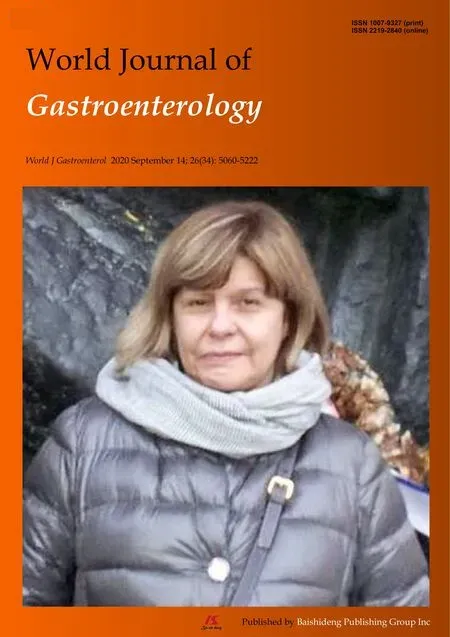Peliosis hepatis complicated by portal hypertension following renal transplantation
Grigory Demyashkin, Margarita Zatsepina
Abstract Peliosis hepatis is a rare benign disease, but in last years the number of identified cases has increased. This disease is known to be sometimes accompanied by hepatocellular carcinoma. In the recent article, Yu et al describe a case of liver peliosis, characterized by an increased proliferative index. Therefore, additional diagnosis of patients should include analyzing other tumor markers expression in order to assess the risk of malignant cell transformation in peliosis hepatis.
Key Words: Peliosis hepatis; Hepatocellular carcinoma; Survivin; Epithelial-mesenchymal transition
TO THE EDITOR
We have read with great interest the manuscript in your journal “Peliosis hepatis complicated by portal hypertension following renal transplantation” by Yuet al[1], which presents a case of a patient developing liver peliosis nine years after kidney transplantation and long-term immunosuppressive therapy. Histological analysis didn’t reveal any malignant cells; however, the authors describe a high proliferative index in hepatocytes and therefore, suppose the development of highly differentiated angiosarcoma.
We appreciate the authors' contribution to drawing attention to this problem and in addition to this study we would like to propose a new approach for the prevention and timely diagnosis of possible malignant transformation against the background of liver peliosis.
In recent years, there has been an increase in the incidence of hepatocellular carcinoma (HCC) and cholangiocellular carcinoma (CCC), which are of great importance among the reasons of cancer-related deaths worldwide[2]. Basic molecular mechanisms of hepatocarcinogenesis include several main ones. A major tumor protein is survivin, which belongs to the inhibitor of apoptosis protein family. It is an unfavorable prognostic factor, including for HCC and CCC, and therefore is used as a tumor marker[3]. In addition, the key factor providing normal liver histoarchitectonics is the presence of tight intercellular junctions formed by the complex of E-cadherin and beta-catenin[4]. E-cadherin is able to suppress cell growth, transformation and invasion and thus, to inhibit tumor progression. Due to decrease in its expression, intercellular adhesion becomes weakened and is followed by cell dissemination to peritumoral area. This hypothesis has been proved for HCC and CCC, which means that there is a clear qualitative and quantitative relationship between these proteins and malignant transformation of hepato- and cholangiocytes. At the same time, betacatenin enters the nucleus and the Wnt signaling pathway of carcinogenesis is activated. The acquisition of cell invasive ability is known as epithelial-mesenchymal transition (EMT) and is followed by increase in vimentin expression[5].
Nevertheless, despite the confirmed significance of survivin in the progression of HCC and CCC, there are no data on its expression in peliosis hepatis, although this marker is a promising prognostic indicator. Few studies have shown that HCC can be accompanied by peliosis[6]. Taking into account the fact of the intercellular contacts destruction in HCC, as well as data on the role of E-cadherin and beta-catenin in peliosis, it can be assumed that HCC is not only present in liver along with peliosis, but may also be a stage of its progression[7]. Still there are no studies that show a clear relationship between these two diseases and consider manifestation of HCC as a final stage of peliosis. Moreover, there is evidence for the presence of vimentin-positive malignant cells in the liver peliosis[8]. The case of Yuet al[1]reports a high proliferative index in peliosis hepatis and therefore, the authors suspect the diagnosis of welldifferentiated angiosarcoma. However, this assumption is not confirmed by any objective methods and does not verify the probability of carcinogenesis against the background of peliosis. This led us to the decision to conduct our own study using the markers mentioned above. A number of questions remain to be unravelled: does EMT occur in peliosis and is it accompanied by weakening of intercellular junctions? Is there a connection between pathogenetic stages of peliosis and malignant transformation in the liver? Last but not least, it is important to understand at which level carcinogenesis is initiated and what is paramount: molecular mechanisms of apoptosis inhibition with survivin involvement or transformation at the cellular level with the destruction of contacts between hepatocytes.
To resolve these questions, it is essential to study the expression of survivin, Ecadherin, beta-catenin and vimentin in cases of peliosis, HCC and CCC, as well as to give comparative assessment of the data obtained. These results can be subsequently used to determine the prognosis of peliosis hepatis, to evaluate the risk of hepatocytes malignant transformation and to prevent tumor progression in a timely manner, which is the most important task in oncological practice.
 World Journal of Gastroenterology2020年34期
World Journal of Gastroenterology2020年34期
- World Journal of Gastroenterology的其它文章
- Endoscopy-based Kyoto classification score of gastritis related to pathological topography of neutrophil activity
- Golgi protein-73: A biomarker for assessing cirrhosis and prognosis of liver disease patients
- Arachidyl amido cholanoic acid improves liver glucose and lipid homeostasis in nonalcoholic steatohepatitis via AMPK and mTOR regulation
- Potential applications of artificial intelligence in colorectal polyps and cancer: Recent advances and prospects
- Transjugular intrahepatic portosystemic shunt for Budd-Chiari syndrome: A comprehensive review
- Mixed epithelial endocrine neoplasms of the colon and rectum – An evolution over time: A systematic review
